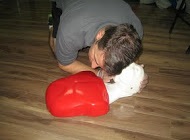
Whether you are studying for your CPR certification, or are looking to renew your certification, it is important to know what pointers to use as a study guide. As is expected, the skills to be tested will differ from one training centre to another. The concept, however, remains the same regardless of the training centre that one attends. To pass your exams, here are tips that will help you review your skills and pass your exams. Remember that these pointers are reviewed by major organizations so you are certain to get help.
What approach should you take when you get to the site of the accident?
CPR certification pointers indicate that you should first assess the situation on the ground. Contact the victim and find out whether they are okay and whether they could do with some help. If the patient is non-responsive, make sure to instruct someone to call for emergency services. This will happen even as you continue to attend to the patient. Put your hand below the patient’s chin and the other on the forehead so that you provide a passage way for the air.
Observe the patient by placing your cheek close to the victim’s nose and mouth. This is done to continually check on the victim’s breathing. As you do this, check to see whether their chest rises and falls as they breathe.
Another pointer when it comes to CPR certification is to give the first two rescue breaths which should indicate a rise in the patient’s chest. Ideally, each of these breaths should last just about a second, and both breaths must be delivered within the first 10 seconds of contact. Check for the pulse in the victim. If the victim is an adult, how do you go about cardios? In such a scenario you ought to give adult CPR. This form of CPR is provided when one takes a comprehensive CPR training course.
Note that in CPR certification, adult CPR and child CPR are different in the ways that they are presented. Both, however, must be availed in intervals of compressions and rescue breaths, all the while allowing for the chest to recover amid the compressions. As you repeat the procedure, you need not check the pulse. Defibrillation is the other procedure that is followed through when administering first aid and CPR. In case you are testing for the CPR process using defibrillation, you will have to approach the victim carefully. You will then choose the correct pads and start the machine.
Following a round of rescue breaths, make available the pads and put them in place prior to the activation of the pulse. When this is complete, follow it through with compressions and rescue breaths in the ratio of 30:2. This will give you ample time to help the patient recover as well as increase the time period required for the medical professionals to arrive at the scene. This pointers are great tips that you must make use of when you want to go for CPR certification.
